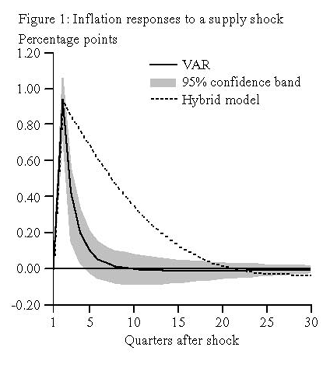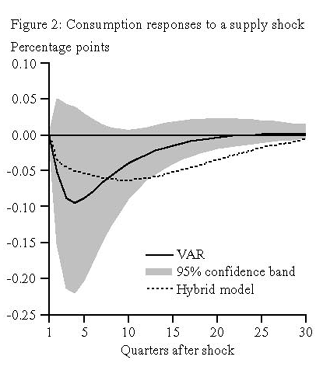Central banks use macroeconomic models to help frame the issues that they face, to mold their ideas, and to guide them in their decisionmaking. While a wide range of models are available, economists are increasingly examining monetary policy issues and the design of optimal monetary policies in the context of “New Keynesian” macroeconomic models.
Central banks use macroeconomic models to help frame the issues that they face, to mold their ideas, and to guide them in their decisionmaking. While a wide range of models are available, economists are increasingly examining monetary policy issues and the design of optimal monetary policies in the context of “New Keynesian” macroeconomic models. New Keynesian models are notable for using microeconomic principles to describe the behavior of households and firms, while allowing price and/or wage rigidities and inefficient market outcomes. One particular model, often called the canonical New Keynesian model, has received special attention, not only because it is easy to work with, but also because it succinctly summarizes the principal mechanisms through which policy interventions affect the economy.
The canonical model does have some drawbacks, however. For example, it arguably does an abysmal job of explaining movements in inflation, interest rates, and output in the U.S. and elsewhere (Estrella and Fuhrer 2002). This poor empirical performance calls into question the value of the policy recommendations that emerge from it. Recognizing this weakness, researchers have developed a new generation of models that retain the microeconomic approach to describing household and firm behavior while also seeking to explain statistically movements in observed data. These “hybrid” New Keynesian models, as they are known, are important because they are rapidly becoming the workhorse models in academic studies of monetary policy. They are often used to construct a benchmark for what constitutes optimal policy behavior, to assess past policy decisions, to study the sources and importance of macroeconomic disturbances, and to quantify the broad economic impact of policy interventions.
In this Economic Letter, we discuss the basic properties of hybrid New Keynesian models and examine the extent to which they successfully explain U.S. macroeconomic data.
Hybrid New Keynesian models have the canonical model at their core, but they introduce a number of important modifications. Typically these modifications seek to generate persistence in output and inflation in order to slow down the rapid adjustments that occur in the canonical model.
Consider, for a moment, the canonical model (see, for example, Rotemberg and Woodford 1997). Households are assumed to smooth consumption by saving or by borrowing against expected future income; specifically, they save more when interest rates are high and consume more when interest rates are low. Firms are assumed to have some market power, allowing those selling similar products to charge different prices. Although firms choose the price that they charge for their product, costs associated with changing prices—re-labeling prices on goods, reprinting menus, etc.—hinder firms from changing prices frequently. As a result, a firm chooses today’s price based not only on current demand for its product but also on the price it expects to be able to sell its product for tomorrow.
The problem with the canonical model is that the behavior of output, consumption, prices, and interest rates suggested by the model are fundamentally at odds with observed data. Ball (1991) shows that the inflation equation in the canonical model implies that a central bank can lower inflation to whatever level it desires without any sacrifice in output or employment, let alone a recession. The reason for this is that models with costly price adjustments lead to persistence, or inertia, in prices, but not in inflation (the rate of change in prices). Measured inflation, however, is highly persistent, and the reduction in inflation that occurred in the early 1980s—commonly associated with tighter monetary policy—was demonstrably not costless in terms of output or employment: from July 1981 to November 1982—the “Volcker recession”—over 2.8 million nonfarm payroll jobs were lost. Similarly, the canonical model suggests that consumers can easily save or borrow against future income to smooth out fluctuations in current income. In contrast, studies typically find little evidence for consumption smoothing (see Hall 1988), finding instead that a reduction in current income generally leads to a decline in consumption (Shea 1995).
Hybrid New Keynesian models modify the canonical model by adding habit formation into consumption behavior. Roughly speaking, habit formation corresponds to the idea that households become accustomed to a certain standard of living and that they dislike having their consumption fall below that standard; but, if their consumption level does drop, then they gradually become accustomed to the lower living standard. Habit formation, in various forms, has been used to explain survey results finding that people in rich countries appear to be no happier than people in poor countries, that some people tend to be less concerned with their own consumption than with what others consume, and that some people tend to change their consumption patterns gradually even after sudden large increases in income. In terms of the hybrid model’s properties, habit formation leads to gradual changes in consumption over time because the standard of living that people become accustomed to depends on past consumption.
Increasingly, hybrid models also modify the canonical model by introducing indexation into firms’ pricing decisions. The basic idea behind price indexation is that firms recognize that prices will tend to rise over time, but they also find it costly to determine continuously the price they should charge for their goods. So, rather than reassess what price they should charge frequently, firms reassess their optimal price setting once a year (say) and simply change their price according to observed inflation on other occasions. While its theoretical motivation is loose, the effect of price indexation is to make inflation persistent. This persistence arises because at any point in time some firms are simply changing their prices according to past inflation.
With these modifications, the canonical model, which had no mechanism for generating persistence, is transformed into a framework in which both households and firms make decisions based on past outcomes as well as on expected future outcomes.
Do hybrid models fit the data?
Given that hybrid New Keynesian models are widely applied and are used to explore policy issues, the question arises whether they adequately describe the behavior of an economy like the U.S. Of course, because they invariably encompass the canonical model, hybrid models will outperform the canonical model from an empirical standpoint, but this does not imply that they necessarily fit the data well. Dennis (2003) develops and estimates a number of hybrid New Keynesian models and assesses how well they describe the U.S. economy between 1982.Q1 and 2002.Q2. Figures 1 and 2 show the estimated responses of inflation and consumption to a transitory supply shock—say, a short-lived oil price shock—using the hybrid model and a Vector AutoRegression (VAR). The VAR uses the past history of the data to uncover statistical relationships among variables, restricting these relationships as little as possible, and, in particular, without imposing the New Keynesian theory on the data. The VAR responses provide a benchmark for comparing the hybrid New Keynesian model results. The shaded regions represent 95% confidence bands around the VAR responses; in other words, according to the VAR, only 5% of the time should we observe outcomes that lie outside these shaded areas. With the VAR providing the benchmark, occasions where the hybrid model’s responses lie outside the shaded regions indicate noteworthy departures from the benchmark behavior.


To understand the figures, it is useful to interpret the responses from the hybrid model in terms of the underlying theory. An adverse supply shock pushes inflation up (Figure 1) causing the central bank to raise interest rates. Higher interest rates induce consumers to defer consumption, causing consumption to fall (Figure 2). Facing lower demand for their product, firms gradually begin to lower their prices, and inflation begins to fall. As time passes, more and more firms lower their prices, and indexing firms respond to falling inflation by also lowering their prices. With inflation gradually falling, the central bank is able to lower interest rates, which stimulates consumption spending. Through this process, inflation and interest rates slowly decline, and consumption slowly rises, back to their previous levels. After about seven years (30 quarters) the shock has largely passed through the economy, having little further impact.
Looking at the responses from the hybrid model, it is clear that habit formation and price indexation introduce considerable inertia into the model—shocks that last only one period lead to sustained movements in consumption and inflation. This inertia represents the hybrid model’s contribution over and above the canonical model. Although the hybrid model does reasonably well in response to demand shocks (not shown), in response to a supply shock there are a number of areas where the hybrid model’s responses differ importantly from the VAR. Specifically, in response to the shock, the hybrid model predicts that consumption and (particularly) inflation will take much longer to return to normal than is evident in U.S. data.
Hybrid New Keynesian models are widely used to explore monetary policy issues and to identify and study the sources and importance of macroeconomic fluctuations. This Economic Letter has discussed the economic behavior that underpins many hybrid New Keynesian models, described how they improve on the canonical model, and examined their ability to replicate important characteristics of U.S. data. By comparing the predictions of an estimated hybrid model to those from a VAR, we found that the hybrid model generally performed well. However, the hybrid model struggled to capture the economy’s response to supply shocks, suggesting that additional work is needed to improve the model’s supply side and its rationale for why inflation is persistent.
Richard Dennis
Economist
References
Ball, Laurence. 1991. “The Genesis of Inflation and the Costs of Disinflation.” Journal of Money, Credit and Banking 23(3) pp. 439-451.
Estrella, Arturo, and Jeffrey Fuhrer. 2002. “Dynamic Inconsistencies: Counterfactual Implications of a Class of Rational-Expectations Models.” American Economic Review 92(4), pp. 1013-1028.
Dennis, Richard. 2003. “New Keynesian Optimal-Policy Models: An Empirical Assessment.” FRBSF Working Paper 2003-16 (August).
/economic-research/papers/2003/wp03-16bk.pdf
Hall, Robert. 1988. “Intertemporal Substitution in Consumption.” Journal of Political Economy 96(2), pp. 339-357.
Rotemberg, Julio, and Michael Woodford. 1997. “An Optimization-based Econometric Framework for the Evaluation of Monetary Policy.” In Ben Bernanke and Julio Rotemberg, eds., NBER Macroeconomics Annual. Cambridge, MA: MIT Press.
Shea, John. 1995. “Union Contracts and the Life-Cycle/Permanent Income Hypothesis.” American Economic Review 85, pp. 186-200.
Opinions expressed in FRBSF Economic Letter do not necessarily reflect the views of the management of the Federal Reserve Bank of San Francisco or of the Board of Governors of the Federal Reserve System. This publication is edited by Anita Todd and Karen Barnes. Permission to reprint portions of articles or whole articles must be obtained in writing. Please send editorial comments and requests for reprint permission to research.library@sf.frb.org